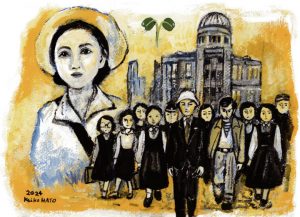Hiroshima and Film < 2 > Sumioka Masaaki – Director and General Manager of Johakyu
Aug. 24, 2024
“Hiroshima” Director: Hideo Sekigawa (Released in 1953)
Hope for buried masterpiece to reach the world
In my 44-year career in the movie industry in Hiroshima, I’ve never been so surprised like this. But at the same time, I feel very ashamed and awful because I had not known of this film. To tell the truth, I had never heard of the film entitled “Hiroshima” until it was screened at the Hatchoza cinema located in the city’s Naka Ward in 2011.
The film was made eight years after the atomic bombing. It was directed by Hideo Sekigawa, who in 1950 made a film entitled “Senbotsu Gakusei no Shuki: Kike Wadatsumi no Koe (Writings of the Fallen Japanese Students: Listen to the Voices from the Sea).” The film, dramatized by Yasutaro Yagi from “Genbaku no Ko (Children of the A-bomb),” a collection of children’s personal accounts about the atomic bombing compiled by the educator Arata Osada, is a masterpiece that attempted to realistically recreate the devastation of Hiroshima immediately after the atomic bombing. Production costs were raised through a fund-raising campaign mainly by what was, at the time, the Japan Teachers’ Union. It is said a total of more than 80,000 citizens, from babies to the elderly, took part in the shooting.
Yumeji Tsukioka, who enthusiastically played the role of a teacher who drowned in the river with children, was an exclusive Shochiku Corporation actress at the time. This Hiroshima-native actress is said to have persuaded the company to allow her to appear in the film without being paid. Prominent celebrities, such as Eiji Okada and Isuzu Yamada, participated in the film as well. Among the assistant directors was a young Kei Kumai.
The story is set in Hiroshima seven years after the atomic bombing. The film depicts the children’s lives as they struggle to cope with their experience of the atomic bombing. The scene in which a horse carrying goods trembled and collapsed at the moment when the atomic bomb was dropped, shocks me every time I see this film. The last scene, in which a crowd of people wishing for peace walk toward the A-bomb Dome, leaves a strong impression.
A major film distributor, out of consideration for the U.S. side, asked to cut some dialogue before its release. But, the production side refused. I really admire their courage, challenge, and sense of mission. Without being distributed by a major film distributor, the film was shown independently. In 1955, however, it won the feature film award at the Berlin International Film Festival.
In 2011, after a long time had passed since the production of the film, I met Ippei Kobayashi, the eldest son of Taihei Kobayashi who was an assistant director of the film “Hiroshima,” and who was working to screen this “buried masterpiece.” We were so impressed by the timeless excellence and sublimity of the film and decided to screen it at Hatchoza for three weeks.
The digital material available at the time was Blu-ray only. A digitally remastered version was completed in 2017, and then we created a digital cinema package (DCP) for digital screening in cinemas at our company’s expense. Since then, the film has been screened almost every August, with audiences growing year by year.
Like “Genbaku no Ko (Children of Hiroshima)” made by the director Kaneto Shindo in 1952, the film was scored by Akira Ifukube. The sound of the explosion of the bomb immediately after it was dropped was expressed by a single piano strike. He also scored “Godzilla” made by the director Inoshiro Honda in 1954, and included a piece adapted from “Hiroshima” in that film. Now, the theme music from “Godzilla” is known to people all over the world. The special film “Hiroshima,” which brought the power of Hiroshima, will continue to attract attention in the future, too.
Masaaki Sumioka
Born in 1951 in Naka Ward, Hiroshima. He joined Salon Cinema (now Johakyu) in 1980. He oversees publication of the program schedule “End Mark” and all-night screenings. He was also involved in the opening of downtown cinemas “Hatchoza” and “Saron Cinema.”
Hato
Born in Otake City in 1981. Her real name is Keito Hata. She creates a wide range of formative arts, including painting, graphic design, stop-motion animation, and theatrical art.
Information on the film
Japan / 104 min. / Black and white / Japan Teachers’ Union Film “Hiroshima” Production Committee [Cinematography] Shunichiro Nakao, Susumu Urashima [Art] Totetsu Hirakawa, Junji Eguchi [Recording] Shigeharu Yasue [Performer] Yoshi Kato, Yasumi Hara, Shizue Kawarazaki, Hatae Kishi, Harue Tone, Takashi Kanda, Masaya Tsukita, Machiko Tokunaga, Kenji Susukida, Masao Mishima, Tokuo Hanazawa, Kinzo Shin
****
In this series, the Chugoku Shimbun will ask a film-loving writer to choose one film and introduce highlights and their memories about their selection. We will post them from time to time.
(Originally published on August 24, 2024)








